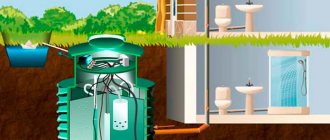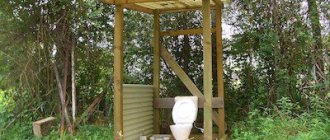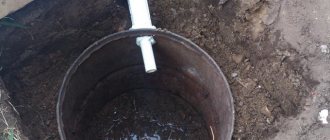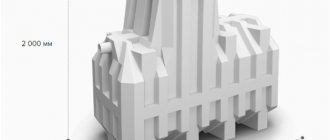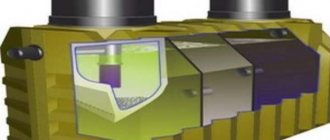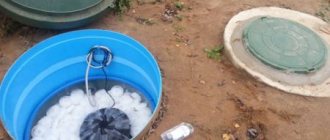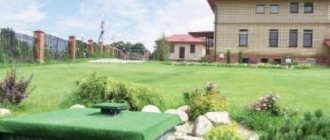Share
An introductory article for those readers who are just deciding on the choice of a device for cleaning sewage in a suburban area. We will tell you what Topas is. General information based on which you can decide whether you need this particular solution, or should you look towards other manufacturers.
Topas is the name of a device for processing household wastewater, which is used in places where it is difficult or impossible to connect to a central sewerage system. For example, for cleaning drains in a country house.
This is what it looks like in a suburban area
Topas belongs to the class of treatment facilities for deep biological treatment and requires electricity for its operation. Although almost everyone calls it a septic tank, this is not correct. The operating principles of a septic tank and a deep biological treatment station are completely different.
People now call septic tanks all devices that perform the function of purifying sewage. Topas, or mistakenly Topaz, is the name given to any biological treatment plant with a green square lid rising above the ground. Over time, the name became a household name, by analogy with the automobile brand “jeep”.
The treatment station is connected to the outlet of the sewer main of the house, and after processing, clean process water comes out.
Layout of the site
Story
TOPAS was designed, received a patent for the invention, and set up production in the Czech Republic by engineer Jan Topol. That's exactly what it is called in English, all over the world. It is called that for a reason. TOP - from the surname Topol, A - activation, C - system. However, in Russia the situation is different - the rights to the Topas trademark belong to the Topol-Eco group of companies.
In the 2000s, Jan Topol entered the Russian market with his products, founding the Topol-Eco company together with several founders, which began production of Topas septic tanks in Russia. A few years later, the campaign was overtaken by a crisis. Jan Topol, together with several founders, left Topol-Eko. Almost everyone who came out founded their own production of treatment facilities of a similar design, but with different names. And Topol went to the Czech Republic to drink beer and work in the European market. True, some of the newly formed companies still continue to cooperate with him.
Topas treatment facilities without queues and long waits
Naturally, this septic tank is a bestseller and a leader in the market of autonomous sewage systems in Russia and the CIS countries. Therefore, during the summer season, namely from May to September, queues traditional for our country form behind the Topas installation.
Most companies that sell and install TOPAS units do not have their own warehouse (since their own warehouse means high rent, the need for their own equipment and security, etc.) and purchase treatment facilities “custom-made” from the factory. That is, he must first wait for the intermediary company to transfer his money to the account of the manufacturer. Then he must wait until the latter processes and confirms his application and his station begins to be manufactured at the plant. As a result, often in the summer the buyer is forced to wait from 2 weeks to a month for the delivery of his station!
In the case of our company, you can pick up the purchased station directly from our warehouse, without waiting for your turn at the treatment plant. We can also deliver it by our own transport directly to your site at any time convenient for you and install it immediately! Unlike small companies, we have a permanent team of installation specialists who are ready to come for installation on weekends or holidays. Don't wait your turn! Buy local treatment facilities Topas from our company, and you will not be disappointed!
What does it look like
The septic tank is a welded polypropylene container in the shape of a parallelepiped with a green neck, ending with a lid. The green color is due solely to the aesthetic component. The cover is located at a level of 20 cm above the ground level and its color is in harmony with the vegetation.
There are several dozen models. They differ in size and productivity: the smallest ones are capable of processing wastewater from 2-4 people, large treatment plants - up to 150 residents. At the same time, 150 is not the limit; several installations can be combined with each other, obtaining a treatment facility of even greater power. Each model has several modifications: according to the method of discharging purified water, the maximum depth of the supply sewer pipe.
Topas-5
Topas-8
Topas-15
Topas-20
Types of designs and model range
To understand the operating principles of a Topas-type septic tank, you should study its design. Externally, this device is a large cube-shaped container with a large square lid.
Inside, it is divided into four functional sections. There is a built-in device for drawing air from the surface to ensure that the effluent is saturated with oxygen.
The Topas septic tank consists of four interconnected chambers that provide multi-stage cleaning. Flowing from one compartment to another, the wastewater settles, is processed by bacteria, disinfected and clarified
The following elements are located inside the treatment system:
- a receiving chamber into which wastewater initially flows;
- an airlift with pumping equipment that ensures the movement of waste between different sections of the device;
- aeration tank - a compartment in which the secondary stage of purification is performed;
- a pyramidal chamber where final wastewater treatment occurs;
- post-treatment chamber, where water purified during the operation of the septic tank accumulates;
- compressor for pumping air;
- sludge removal hose;
- device for discharging purified water.
The range of septic tanks of this brand is quite wide. There are models for plots and houses of different sizes, devices designed to service gas stations and even powerful wastewater treatment plants that can satisfy the needs of a small village.
This diagram clearly shows the structure of the Topas septic tank. It consists of four different sections through which the waste coming through the sewer pipe moves
In private housing construction, septic tanks “Topas-5” and “Topas-8” are most often used. The number next to the name indicates the approximate number of residents the device is designed to serve.
“Topas-5” has a more compact size and lower productivity; it is able to easily meet the needs of a family of five for sewerage services.
This model is considered the ideal choice for a relatively small cottage. Such a device can process about 1000 liters of waste per day, and the simultaneous discharge of waste within 220 liters will not cause any harm to the septic tank.
The dimensions of Topas-5 are 2500x1100x1200 mm, and the weight is 230 kg. The power consumption of the device is 1.5 kW per day.
But for a large cottage it is better to take “Topas-8”. The dimensions and ability to process wastewater are significantly higher for this model. Such a septic tank can even serve areas where a swimming pool is located, although in such a situation Topas-10 may be more appropriate.
The productivity of such models varies between 1500-2000 liters of wastewater per day.
The numbers next to the name of the septic tank indicate the number of people that this device can serve when used simultaneously. Buyers are guided by these indicators when choosing a suitable model.
There is also a letter marking that describes the special operating conditions for which a particular device is designed.
For example, the designation “Long” indicates the possibility of using this septic tank with a connection depth that exceeds 80 cm. The marking “Pr” indicates models with the option of forced pumping of partially purified water.
Such designs are additionally equipped with a pump. Models marked “Pr” are used in areas with high groundwater levels.
Topas septic tank models may vary depending on the volume of wastewater processed, as well as operating conditions. For example, for areas with high groundwater levels, it is recommended to choose a septic tank marked “Pr”
The presence of a pump in the device of this model of the Topas septic tank is intended for installation in an area with clay soils that filter poorly or do not absorb purified water at all. The “Us” marking simply stands for “reinforced.”
These are more powerful models that should be used if the installation depth of the septic tank exceeds the level of the sewer pipe by 1.4 m or more.
The higher the pump's performance, its power and the more options it has, the more expensive it will be to purchase, and the more difficult it will be to install. Therefore, you should not choose a treatment facility “for growth” if in the near future the number of residents in the house is not expected to increase sharply.
More detailed recommendations for choosing a septic tank for a summer residence are discussed in our other article.
What is inside
Inside the housing there are several compartments for various purposes, through which wastewater is purified. They can be disposed of without fear of sanctions from environmental authorities. Treated wastewater does not harm the environment and does not have an unpleasant odor.
Location of compartments
According to the cleaning principle, Topas is a relative of large urban wastewater treatment plants, with the difference that all cleaning processes take place inside one compact housing. At the same time, it is not afraid of frost, does not require the addition of biological additives or calling a vacuum cleaner.
Read more about the device in the article: How Topas works. Schemes and principles of operation.
The design involves the use of sewerage in summer and winter. In this case, no special insulation measures are required. Although some users still prefer to play it safe by covering the lid with sheets of thermal insulation material.
For almost twenty years of existence on the Russian market, this septic tank has deservedly become one of the most popular solutions for wastewater treatment. This is explained by the high quality of purified water at the outlet, compactness, ease of installation, and the ability to perform maintenance yourself. But despite all its advantages, it is not suitable for everyone and is not without its disadvantages.
Operating principle of Topas septic tanks
The wastewater flows through the sewer pipe into the first receiving chamber. Here, sewage masses are fermented with the active participation of anaerobic bacteria.
When the level of waste in the receiver reaches a predetermined level, waste is pumped into the second chamber using an airlift.
Wastewater enters the receiving chamber, in the second it is saturated with oxygen and processed by aerobic bacteria, in the third it is settled, and in the fourth it is decomposed into sludge and 98% purified water.
In the second section of the septic tank, aeration of the wastewater is performed, i.e. saturating them with air, which is necessary in order to activate the work of aerobic microorganisms digesting sewage organics.
Bacteria actively process the contents of the sewer, turning it into a mixture of partially clarified and purified water and activated sludge.
After processing in the second chamber, everything moves to the sludge stabilizer section - biomass, which is actively involved in cleaning the liquid component of the sewer mass. Here the sludge settles, and the resulting water moves into the settling tank.
To improve the quality of treatment, part of the water and moving sludge from the stabilizer enters the primary chamber so that secondary wastewater treatment can be performed.
Thus, the operation scheme of the Topas septic tank provides for the circulation of wastewater through various compartments of the septic tank until the level of purification reaches the required quality level. This ensures the high safety of processed wastewater for the environment.
If the section of the site is composed of sandy soil, then it is better to install an absorption well to discharge wastewater. Its construction is possible only if there is at least 1 meter between the conditional bottom of the filter well and the groundwater table
Upon completion of multi-stage processing, purified water is discharged into filtration fields or an absorption (filter) well, where the wastewater is further purified and discharged into the ground.
If it is not possible to arrange a filter well or drainage system, the clarified and disinfected liquid can be discharged into the drain.
If the septic tank is installed in clay soil, the treated and disinfected wastewater is disposed of in a sewer ditch
In an absorption well or in filtration fields, post-treatment is carried out by passing wastewater through filter soils. In the first case, the post-treatment design is a pit with a permeable bottom, on which a meter-long layer of crushed stone or gravel with sand filler is placed.
The filtration field is a kind of drainage system made of perforated pipes - drains. Flowing through the drains, the liquid component of the wastewater is further purified and seeps through the perforations of the pipes into the surrounding soil.
We also recommend that you familiarize yourself with the features of laying drainage pipes.
When laying all types of sewer pipelines, including the drainage system, the level of soil freezing in winter should be taken into account so that the wastewater does not freeze and create plugs in the channel intended for its flow.
If there is unused land near the site or the country estate has an impressive area, the wastewater disposal system can be implemented in the form of drains that carry out additional treatment and discharge water into the ground
Advantages
- High quality of cleaning – more than 95%;
- The minimum occupied area on the site is from 1 sq.m.;
- Easy installation - completed in 1 day, does not require a concrete base* or anchoring;
- During operation, does not require pumping with a sewer truck;
- Suitable for permanent use, seasonal living;
- Easy maintenance that you can do yourself;
- No need to add activators or various dietary supplements;
- The plastic case is not subject to corrosion, the service life declared by the manufacturer is more than 50 years;
- Excellently withstands all the hardships of the Russian climate;
- No unpleasant odors.
* - the concrete base is poured for models designed for more than 20 residents.
Flaws
- Sewage will not be properly treated in the complete absence of fecal waste;
- Volatility dependence - without the availability of electricity, Topas turns into a storage tank;
- You cannot buy “with a reserve” for the future; you should choose based on the planned number of residents;
- Not everything can be processed by Topas. It is necessary to control the nature of the wastewater. Read what you can throw into Topas and what you can’t;
- Don't forget about maintenance for too long.
Analysis of shortcomings If the first point is critical for you, then start looking for another solution.
Energy dependence: this disadvantage is very conditional. During short-term power outages in the house, in addition to the treatment plant, other engineering systems (pumps, boilers) do not work. Water consumption by residents at this moment is minimal, so such utility difficulties are not at all critical. It’s another matter if there are regular long-term interruptions (for several days) in the power supply. Then you still have to look for another non-volatile solution.
You really can’t buy a septic tank with a reserve. If you install Topas-20 (for 20 residents), and five people use it, and only on weekends, then you will not get high-quality work from the system. Here, too, there is something to think about... Why install an installation of obviously higher power? You can always complement a small installation with another one by combining them into a common system. Or install 2 small models at once, mothballing one of them and launching it as needed.
Regarding what can be drained into the sewer, the following can be said. For frequent owners, this is a matter of discipline and can be solved quite simply. For wastewater treatment plants with a large number of residents, where it is impossible to keep track of everyone, there are engineering solutions that allow minimizing harm to the installation from the discharge of unwanted wastewater.
A sewage treatment plant, like any equipment, requires some attention. Don't forget about this. Before making a purchasing decision, you can evaluate the difficulty of performing Topas maintenance yourself. Or you can entrust this work to our service department.
How should a Topas septic tank be maintained?
There are two opposing opinions about the maintenance of Topas septic tanks. Some believe that after installing VOC, they will never have to deal with it again. Others believe that maintaining a biorefinery station is a complex process that will require a lot of effort from the owner. In fact, both of these opinions are wrong. It is necessary to maintain the Topas station, but the process is not complicated.
Waste removal
In the process of wastewater purification, a sediment is formed - activated sludge, which contains mainly aerobic microorganisms. Under favorable conditions (with sufficient drainage and oxygen), colonies will grow larger, so excess sludge will need to be removed from time to time.
If this is not done, the quality of cleaning will deteriorate, and subsequently you will have to repair Topas septic tanks. In a septic tank, excess sludge from the settling tank is transported to a stabilizer chamber, where its mineralization occurs. The sludge will need to be removed from the stabilizer periodically.
Advice! When cleaning the activated sludge stabilizer, it is recommended to follow safety precautions: work should be done with gloves, and after completing the process you will need to wash your hands with soap.
Sludge should be pumped out using an airlift (a pump installed in a stabilizer chamber) approximately once a quarter. The work goes like this:
- remove the plug;
- install a waste collection bucket;
- direct the hose into the bucket and turn on the pump.
If the farm has a fecal pump, then sludge can be pumped out using this equipment. In this case, cleaning work can be carried out less frequently - approximately twice a year.
Advice! After completing pumping out the wastewater, be sure to fill the chamber with clean water.
Cleaning
Mandatory measures include cleaning. The coarse filter and airlifts need to be cleaned. In addition, from time to time it is necessary to remove waste from the receiving chamber with a net that cannot be processed by bacteria. Let's consider the process of cleaning a Topas septic tank:
- the hoses that supply air to the airlifts are disconnected, after which the pumps are removed from the housing;
- the clips are removed and the coarse filter is removed;
- devices are washed inside and outside with a stream of water supplied under pressure;
- the nozzles installed in the air distributor should be cleaned with a needle;
- After washing, you should reinstall the equipment, performing the operations in reverse order.
Price
Now about the main thing. At the time of publication of the material, the dealer cost of Topas-S - 4 minimum productivity, designed for 2-4 residents, is 71,010 rubles. Add here the cost of delivery, turnkey installation, and the price of associated costs (and believe me, there will be some). The total cost of installation on a summer cottage will cost you at least 95,000-100,000 rubles.
We told you what Topas is and now the choice is yours. If you are ready to get all its advantages, the disadvantages are not scary, and the price is reasonable, then we will continue to delve into the design features. Or you can order an engineer to come to your site. On the spot, he will tell you everything, tell you what is better, cheaper and calculate all the options. The most important thing is that it's free.
Next: Design and principle of operation of Topas
If the article was useful to you, share the link with your friends

